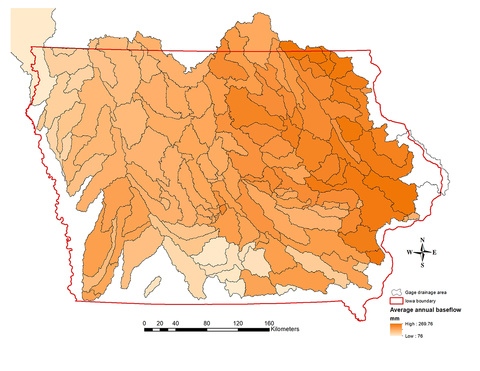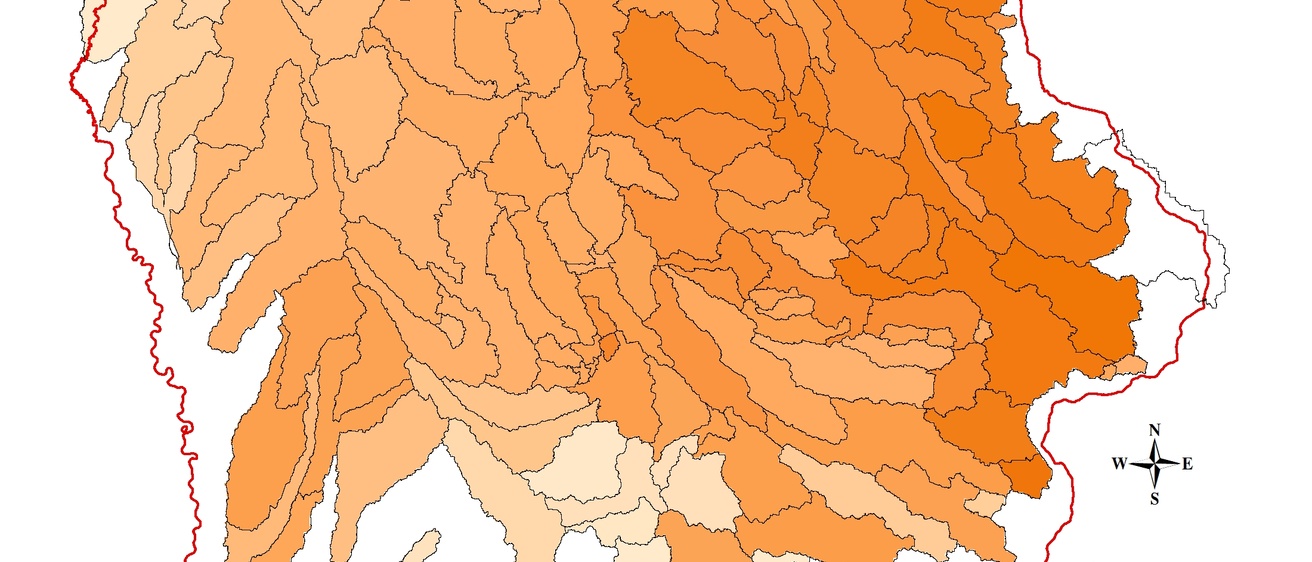Keith Schilling, Iowa Geological Survey, University of Iowa
Despite being largely hidden from view, Iowans rely heavily on groundwater as a water supply for a variety of domestic, agricultural and industrial uses, including 80% of Iowa residents who depend on groundwater for their drinking water (Prior et al., 2003). Groundwater also discharges to streams and rivers as baseflow, providing on average about 40-60% of the annual flow to surface water (Schilling and Libra, 2003). Given how important groundwater resources are to the State of Iowa, it is critical to begin thinking about the implications of climate change on groundwater sustainability. Groundwater supplies are not uniformly distributed across the state, and climate risks will vary based on aquifer locations and depths, water availability and vulnerability to contamination. In this blog post, I will focus on the sustainability of unconfined aquifers in Iowa.

Groundwater in unconfined aquifers is open to the atmosphere and it is not capped by low permeable materials such as shale or fine-grained glacial till. Groundwater levels are replenished with rainfall infiltrating into soils and seeping downward to the water table. Sometimes near rivers and streams, surface water can seep into the groundwater beneath the river but this condition is not typically observed in Iowa. Over the last 20 years, annual groundwater recharge in Iowa averaged approximately 8.7 inches and increased from west to east across the state following trends in total annual precipitation (Fig. 1) (Schilling et al., 2021). In a typical year, approximately 25 percent of rainfall enters the water table as groundwater recharge, but this amount can be extremely variable. Over an 18-year period (2000 to 2017), groundwater recharge increased in Iowa (Fig. 2) but trends that include 2020-21 drought have not been assessed. Recharge is typically concentrated in the months of May and June, which account for about two-thirds of the annual amount. Because groundwater in unconfined aquifers is recharged by rainfall, the quantity of groundwater available in these systems will be extremely vulnerable to climate patterns. During a severe drought, the state receives only about 2–3 inches of groundwater recharge, and when this occurs, there are consequences for water supply providers, river enthusiasts, and the agriculture industry. Drought losses are the largest category of U.S. Department of Agriculture (USDA) crop insurance payments made to Iowa agricultural producers (Schilling et al., 2021).

In northeast Iowa, there is limited soil cover over fractured and solutionally-enhanced carbonate rocks and the uppermost aquifer is largely an unconfined aquifer system in the karst bedrock. Karst refers to sinkholes, caverns, losing streams and springs, and these features are common in this area. These aquifers respond very rapidly to surface water inputs from rainfall, snowmelt and runoff (Schilling et al., 2019; Rowden et al., 2001; Hallberg, 1983). Water levels in the karstic upper bedrock units are largely stable despite variations in rainfall recharge, because the networks of interconnected fractures in the aquifer holds a tremendous quantity of groundwater. However, the rapid movement of surface water into the aquifer makes them highly prone to contamination from land surface activities.
Sustainability of Groundwater in Unconfined Aquifers
Projected changes in groundwater quantity available in unconfined aquifers will be dependent on precipitation recharge and the amount of water removed by pumping. Since groundwater recharge is closely coupled to rainfall, increasing precipitation will result in increasing groundwater recharge that will raise water table levels and increase the sustainability of shallow aquifer. Conversely, less rainfall or snowmelt will result in less groundwater recharge and long-term water table lowering.
Water suppliers using unconfined aquifers are primarily located nears rivers and draw water from the shallow sand and gravel deposits found in the floodplains. Many of these shallow alluvial systems are located in western and southern Iowa where deeper bedrock sources of groundwater are less useable and these aquifers often serve as the sole source of water supply for the rural communities and agricultural producers. Alluvial aquifers are shallow (<50 feet) with water yields that can vary tremendously due to the influence of aquifer properties and the spatial distribution of recharge and pumping stress. There is rapidly increasing demand for water in the region by rural water systems, irrigators, livestock producers, and rural communities and these demands are placing the sustainability of the alluvial aquifers in peril.
Future concerns are being raised due to the frequent occurrence of droughts and increasing withdrawals associated with expansion of animal feeding operations (AFOs) and rural water systems. Many regions of Iowa experienced widespread drought in 2012 and 2013, and river discharge in many rivers reached historic lows. When streamflows are low, wells within approximately 400 m of a river and its tributaries must cease pumping (IAC). Vogelgesang et al. (2014) reported that flow in northwest Iowa’s Rock River during 2013 was within 1 cubic foot per second from implementation of pumping restrictions in 37 wells. The future risk associated with recent droughts is increasing due to changes in water distribution and use. The rapid expansion of rural water systems and the concentration of livestock in animal feeding operations (AFOs) threatens unconfined groundwater supply systems during drought. Unlike the past when most farms and small rural communities relied on their own wells for water supply, regional rural water systems now serve broad areas and supply most of the water to individual farms, livestock producers, AFOs, and rural communities. During drought, rural water systems are forced to ration their water supplies, look for new emergency water sources, and move toward restricting uses among competing groups. For some rural water systems in northwest Iowa, where 95% of the water is used by the livestock industry, reduced water allocation to livestock uses could potentially devastate the industry.
Many Iowa communities served by alluvial aquifers have investigated strategies to increase their sustainability during droughts including adding floodplain features that encourage recharge and surface and groundwater connections, such as recharge basins (Gannon et al., 2017), rock-riffle structures (Gannon and Vogelgesang, 2015), floodplain ponds (Holt e t al., 2017), and re-meandering rivers (Vogelgesang et al., 2017). Improved management of pumping rates in alluvial aquifers can also reduce well inference issues and improve long-term sustainability (e.g., Gannon, 2012; Gannon, 2013; Gannon and Vogelgesang, 2013).
References
Gannon, J.M. 2012. Aquifer Characterization and Drought Assessment, Floyd River Alluvial Aquifer. Water Resources Investigation Report 6, Iowa Geological Survey, Iowa City, IA.
Gannon, J.M. 2013. Groundwater Availability Modeling Under Drought Conditions, Lower Racoon River Aquifer, Dallas and Polk Counties, Iowa, Drought Assessment. Water Resources Investigation Report 7, Iowa Geological Survey, Iowa City, IA.
Gannon, J.M. and Vogelgesang, J.A., 2013. Aquifer Characterization and Drought Assessment, Ocheyedan River Alluvial Aquifer. Water Resources Investigation Report 10, Iowa Geological Survey, Iowa City, IA.
Gannon, J.M. and Vogelgesang, J.A., 2015. Drought Assessment and Local Scale Modeling of the Sioux Center Alluvial Wellfield. Water Resources Investigation Report 13, Iowa Geological Survey, Iowa City, IA.
Gannon, J.M., Holt, N.L. and Vogelgesang, J.A., 2017. Investigation of a recharge basin to improve drought resiliency and aquifer sustainability: Rock Valley Rural Water. Water Resources Investigation Report 15, Iowa Geological Survey, Iowa City, IA.
Hallberg, G.R., Hoyer, B.E., Bettis III, E.A., Libra, R.D., 1983. Hydrogeology, water quality and land management in the Big Spring basin, Clayton County, Iowa. Iowa Geological Survey Open-File Report 83-3, Iowa Department of Natural Resources, Iowa City, IA, 191p.
Holt, N.L., Gannon, J.M. and Vogelgesang, J.A., 2017. Investigation of a Floodplain Pond to Improve Alluvial Aquifer Sustainability: A Quantity and Quality Report. Water Resources Investigation Report 16, Iowa Geological Survey, Iowa City, IA.
Prior, J.C., Boekhoff, J.L., Howes, M.R., Libra, R.D. and VanDorpe, P.E., 2003. Iowa's Groundwater Basics: A geological guide to the occurrence, use, and vulnerability of Iowa's aquifers.
Rowden, R.D., Liu, H. and Libra, R.D., 2001. Results from the Big Spring basin water quality monitoring and demonstration projects, Iowa, USA. Hydrogeology journal, 9(5), pp.487-497.
Schilling, K.E., Jones, C.S., Clark, R.J., Libra, R.D., Liang, X. and Zhang, Y.K., 2019. Contrasting NO3-N concentration patterns at two karst springs in Iowa (USA): insights on aquifer nitrogen storage and delivery. Hydrogeology Journal, 27(4), pp.1389-1400.
Schilling, K.E., Langel, R.J., Wolter, C.F. and Arenas-Amado, A., 2021. Using baseflow to quantify diffuse groundwater recharge and drought at a regional scale. Journal of Hydrology, 602, p.126765.
Schilling, K.E. and Libra, R.D., 2003. Increased baseflow in Iowa over the second half of the 20th century JAWRA Journal of the American Water Resources Association, 39(4), pp.851-860.
Schilling, K.E. and Wolter, C.F., 2001. Contribution of base flow to nonpoint source pollution loads in an
Vogelgesang, J.A., Gannon, J.M. and Quade, D.J., 2014. Aquifer Characterization and Drought Assessment Rock River Alluvial Aquifer. Water Resources Investigation Report 9, Iowa Geological Survey, Iowa City, IA.
Vogelgesang, J.A., Holt, N.L and Gannon, J.M. 2017. Aquifer sustainability at the Osceola County Rural Water System H-Series wellfield, Water Resources Investigation Report 17, Iowa Geological Survey, Iowa City, IA.
